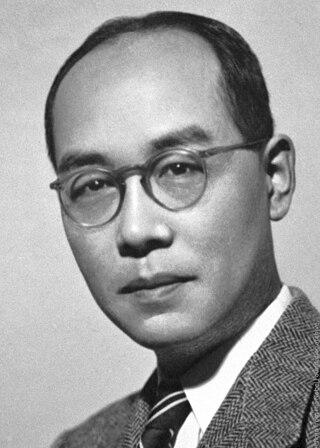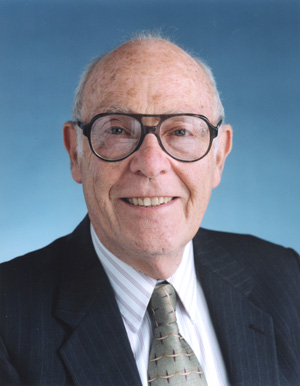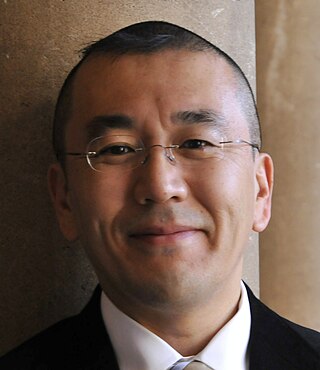Related Research Articles

Hideki Yukawa was a Japanese theoretical physicist and the first Japanese Nobel laureate for his prediction of the pi meson, or pion.

Richard Manning Karp is an American computer scientist and computational theorist at the University of California, Berkeley. He is most notable for his research in the theory of algorithms, for which he received a Turing Award in 1985, The Benjamin Franklin Medal in Computer and Cognitive Science in 2004, and the Kyoto Prize in 2008.

Sir Michael Victor Berry is a British theoretical physicist. He is the Melville Wills Professor of Physics (Emeritus) at the University of Bristol.
Mikio Sato was a Japanese mathematician known for founding the fields of algebraic analysis, hyperfunctions, and holonomic quantum fields. He was a professor at the Research Institute for Mathematical Sciences in Kyoto.

Rudolf Emil Kálmán was a Hungarian-American electrical engineer, mathematician, and inventor. He is most noted for his co-invention and development of the Kalman filter, a mathematical algorithm that is widely used in signal processing, control systems, and guidance, navigation and control. For this work, U.S. President Barack Obama awarded Kálmán the National Medal of Science on October 7, 2009.

Indian astronomy refers to astronomy practiced in the Indian subcontinent. It has a long history stretching from pre-historic to modern times. Some of the earliest roots of Indian astronomy can be dated to the period of Indus Valley civilisation or earlier. Astronomy later developed as a discipline of Vedanga, or one of the "auxiliary disciplines" associated with the study of the Vedas dating 1500 BCE or older. The oldest known text is the Vedanga Jyotisha, dated to 1400–1200 BCE.

John Werner Cahn was an American scientist and recipient of the 1998 National Medal of Science. Born in Cologne, Weimar Germany, he was a professor in the department of metallurgy at the Massachusetts Institute of Technology (MIT) from 1964 to 1978. From 1977, he held a position at the National Institute of Standards and Technology. Cahn had a profound influence on the course of materials research during his career. One of the foremost authorities on thermodynamics, Cahn applied the basic laws of thermodynamics to describe and predict a wide range of physical phenomena.

Hirotsugu Akaike was a Japanese statistician. In the early 1970s, he formulated the Akaike information criterion (AIC). AIC is now widely used for model selection, which is commonly the most difficult aspect of statistical inference; additionally, AIC is the basis of a paradigm for the foundations of statistics. Akaike also made major contributions to the study of time series. As well, he had a large role in the general development of statistics in Japan.

The Bakhshali manuscript is an ancient Indian mathematical text written on birch bark that was found in 1881 in the village of Bakhshali, Mardan. It is perhaps "the oldest extant manuscript in Indian mathematics". For some portions a carbon-date was proposed of AD 224–383 while for other portions a carbon-date as late as AD 885–993 in a recent study, but the dating has been criticised by specialists on methodological grounds. The manuscript contains the earliest known Indian use of a zero symbol. It is written in a form of literary Sanskrit influenced by contemporary dialects.

Conjeevaram Srirangachari SeshadriFRS was an Indian mathematician. He was the founder and director-emeritus of the Chennai Mathematical Institute, and is known for his work in algebraic geometry. The Seshadri constant is named after him. He was also known for his collaboration with mathematician M. S. Narasimhan, for their proof of the Narasimhan–Seshadri theorem which proved the necessary conditions for stable vector bundles on a Riemann surface.
Simon Asher Levin is an American ecologist and the James S. McDonnell Distinguished University Professor in Ecology and Evolutionary Biology and the director of the Center for BioComplexity at Princeton University. He specializes in using mathematical modeling and empirical studies in the understanding of macroscopic patterns of ecosystems and biological diversities.
Yoshiki Kuramoto is a Japanese physicist in the Nonlinear Dynamics group at Kyoto University who formulated the Kuramoto model and is also known for the Kuramoto–Sivashinsky equation. He is also the discoverer of so-called chimera states in networks of coupled oscillators.

Toshihide Maskawa was a Japanese theoretical physicist known for his work on CP-violation who was awarded one quarter of the 2008 Nobel Prize in Physics "for the discovery of the origin of the broken symmetry which predicts the existence of at least three families of quarks in nature."
Satya Atluri was an Indian-American engineer, educator, researcher and scientist in aerospace engineering, mechanical engineering and computational sciences, who was a Distinguished Professor Emeritus of Aerospace Engineering at the University of California, Irvine.

Hirosi Ooguri is a theoretical physicist working on quantum field theory, quantum gravity, superstring theory, and their interfaces with mathematics. He is Fred Kavli Professor of Theoretical Physics and Mathematics and the Founding Director of the Walter Burke Institute for Theoretical Physics at California Institute of Technology. He is also the director of the Kavli Institute for the Physics and Mathematics at the University of Tokyo and is the chair of the board of trustees of the Aspen Center for Physics in Colorado.

Yoshinori Ohsumi is a Japanese cell biologist specializing in autophagy, the process that cells use to destroy and recycle cellular components. Ohsumi is a professor at Tokyo Institute of Technology's Institute of Innovative Research. He received the Kyoto Prize for Basic Sciences in 2012, the 2016 Nobel Prize in Physiology or Medicine, and the 2017 Breakthrough Prize in Life Sciences for his discoveries of mechanisms for autophagy.
Debi Prasad Sarkar is an Indian biochemist, immunologist and virologist. Currently Prof Sarkar has been appointed as a Guest Professor in the Dept. of Biological Sciences and Engineering, IIT Gandhinagar, Palaj, Gujarat. Before joining IIT Gandhinagar, he worked as a Visiting Professor of Chemistry, Ashoka University, Sonipat, Haryana. He was the head of biochemistry department and dean FIAS, at the University of Delhi South Campus and served as the director of IISER Mohali from 2017 to 2019. He then resumed his professorship and subsequently promoted to the post of senior professor of biochemistry, with effect from 18 July 2019 at the parent institute, University of Delhi. Serving as joint director, DSSEED, IoE, University of Delhi. On the scientific front, he is renowned for his researches on Sendai virus and developing reconstituted viral envelopes. He is an elected fellow of Indian Academy of Sciences, National Academy of Sciences, India and Indian National Science Academy. The Council of Scientific and Industrial Research, the apex agency of the Government of India for scientific research, awarded him the Shanti Swarup Bhatnagar Prize for Science and Technology, one of the highest Indian Science Awards, in 1998, for his contributions to Biological Sciences. Received Excellence Teacher Award on service by the University of Delhi.
Jesper Lützen is a Danish historian of mathematics and the physical sciences.
Kaoru Ono is a Japanese mathematician, specializing in symplectic geometry. He is a professor at the Research Institute for Mathematical Sciences (RIMS) at Kyoto University.
Akkihebbal Ramaiah (Ravi) Ravishankara ForMemRS FAAAS FRSC is a scientist specializing in Chemistry and Atmospheric Sciences, and University Distinguished Professor in the Departments of Chemistry and Atmospheric Sciences at Colorado State University, Fort Collins.
References
- 1 2 3 "Hayashi Takao". J-Global. Japan Science and Technology Agency. Retrieved 28 July 2023.
- ↑ "Takao Hayashi". Britannica. Encyclopedia Britannica. Retrieved 28 July 2023.